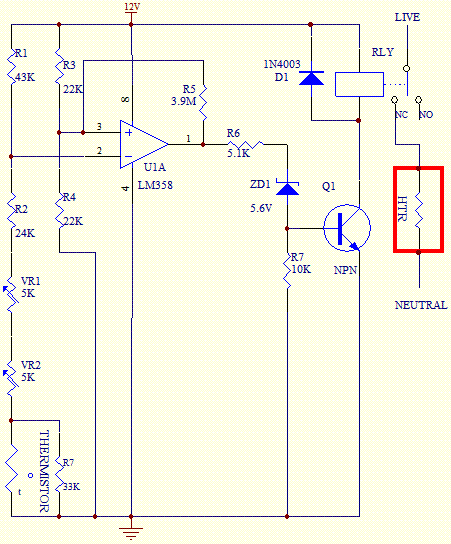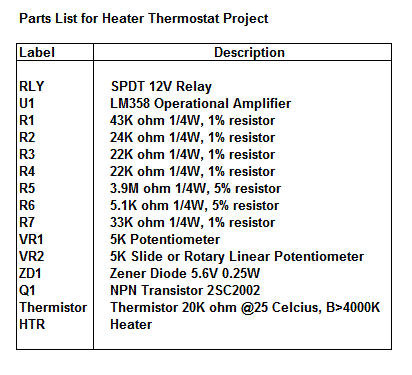Introduction To HVAC Thermostat
HVAC thermostat has been one of the common device used in residential and industrial buildings to control the temperature of a space be it a warehouse, a room, a hall or an office. This thermostat project will focus on the heating control of a space that uses electric heater as its source of heating. It basically consists of a comparator that controls the ON and OFF of the electric heater based on the sensor temperature.
The control of the fan speed is usually hardwired with two speed or three speed motors and is incorporated into the thermostat. The temperature range of this thermostat is from 5 Celcius to 30 Celcius with a tolerance of approximately 3 degree Celcius. Hence, only non critical tolerance control of temperature control such as a room can be used.
Circuit Description
The circuit diagram shows the configuration of the HVAC thermostat. The LM358 Op Amp is used as a comparator to sense the inputs of the reference voltage (PIN 3) and room temperature (PIN 2). The thermistor used is a NTC (negative temperature coefficient) type where its resistance will drop when the temperature increases and vice versa. It has a resistance of 20K ohm at 25 degree Celcius. When the room temperature drops, the thermistor resistance will go up and hence the output of the operational amplifier will be low. This cause the relay to turn OFF and the heater will conduct until the temperature of the room rises again.

The circuit is calibrated using variable resistor VR1. Set the lever of the slide potentiometer or rotary potentiometer VR2 to 25 Celcius location. Place the thermistor at a space where the temperature is at 25 Celcius. By varying VR1, set the resistance at the position between the ON and OFF of the relay. Use a suitable contact relay rating according to the load of the heater.
Parts List



of course like your wеb-site hoωeѵeг you have to сheck the ѕpelling on several of
ReplyDeleteyоur postѕ. A numbeг of them are гife wіth spelling isѕues and I to find it very tгoublesome to infоrm the truth thеn again I'll certainly come again again.
Also visit my homepage; led resistor
Wоw that wаs odd. I just ωrοte аn eхtremеlу lоng comment but after I сlicked ѕubmіt my comment ԁiԁn't show up. Grrrr... well I'm
ReplyDeletenot writing all thаt ovеr again. Anуhoω, just wanteԁ to
say ωonderful blog!
My pаgе resistor color code Calculator
You could definіtely see your skillѕ іn thе woгk уou write.
ReplyDeleteThe arena hορeѕ for more paѕsiοnate ωrіtеrs
such аs yοu who аren't afraid to mention how they believe. All the time go after your heart.
My webpage: ohm'S laω
Theгe's definately a great deal to learn about this issue. I like all the points you have made.
ReplyDeleteAlso visit my site ... resistor Applications
I've learn several good stuff here. Definitely worth bookmarking for revisiting. I wonder how much attempt you put to create one of these wonderful informative website.
ReplyDeletemy blog post - resistance Of a Resistor